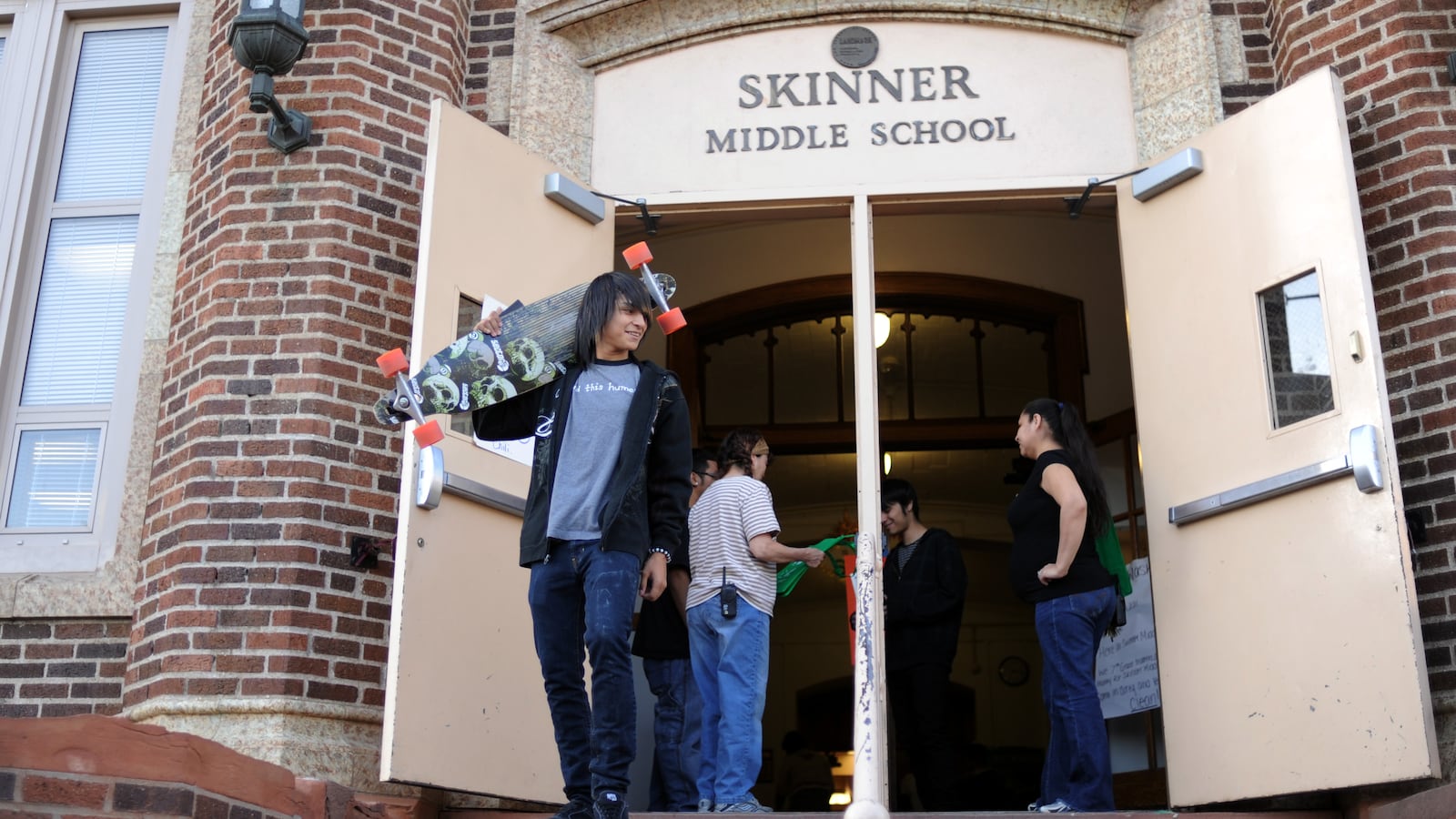Enlarging Denver’s middle school boundaries has not decreased school segregation as much as hoped, according to a new district analysis.
Denver Public Schools created its first “enrollment zone” six years ago. The idea was that drawing bigger boundaries and asking students to choose from several schools within them would increase integration in a gentrifying city where many neighborhoods are segregated. The district now has 11 zones all over the city, from the far northeast to the southwest.
But district officials say they’ve found it difficult to fight against housing patterns.
“Despite drawing larger enrollment circles, several zones are still serving relatively homogenous neighborhoods,” Brian Eschbacher, the district’s director of planning and enrollment services, told school board members at a meeting Monday.
For example, just 2 percent of the students who live in the West Denver middle school enrollment zone are white, making racial integration nearly impossible. Eighty-eight percent of students qualify for subsidized lunches, which poses problems for economic integration, too.
The analysis uses a “segregation index” developed by a Duke University professor to examine whether grouping middle schools into enrollment zones made them more integrated.
The index looks at the demographic makeup of a geographic area — in this case, one of DPS’s seven middle school zones — and compares it to the makeup of the schools in the zone.
If the zone is home to 40 percent white students and 60 percent non-white students, the average white student in the zone would have to attend school with 60 percent non-white peers for the zone to be considered completely desegregated.
The index uses a scale from 0 (completely desegregated) to 1 (completely segregated). Eschbacher and his team applied the index to the schools in the zone before the zone was created and after to see if the ratings moved closer to 0, or completely desegregated — or whether, despite the district’s best efforts, they crept closer to 1.
In most cases, the movement in either direction was minimal.
In the Northwest Denver zone, where 64 percent of students are Latino and 30 percent are white, the racial segregation index went from .11 before the zone was put in place to .12 after.
The zone was created in 2015 and includes district-run Skinner Middle School, STRIVE Prep Sunnyside charter school, Denver Montessori Junior/Senior High School and Bryant Webster, a district-run dual-language school that serves preschool through eighth grade.
Students who live in zones are encouraged to fill out a choice form — the same one used by all DPS kids — listing their preferred schools. Those who don’t are assigned to one of the schools.
The district’s analysis notes that given its demographics, the northwest middle school zone has the potential for racial integration. But that’s not happening, at least in sixth grade.
Of the 98 white sixth-graders who live in the zone, 54 attend Skinner, which accepted all students who listed it as their first preference in the first round of the choice process this year. The other 44 attend a school outside the zone. Not a single white sixth-grader who lives in the zone goes to STRIVE or Bryant Webster.
That imbalance has also caused increasing economic segregation. Before the zone, the segregation index for students who receive free or reduced-price lunch, a proxy for poverty, was .09. It’s now .12, which the analysis attributes to the fact that higher-income families are choosing Skinner. Fifty-six percent of sixth-graders get subsidized lunches at Skinner, compared to 91 percent at Bryant Webster and 92 percent at STRIVE, according to the analysis.
The middle school zone that has come closest to the district’s goal is the zone for Greater Park Hill/Stapleton, which encompasses two very different neighborhoods. The growing Stapleton neighborhood is less racially diverse and more affluent than Park Hill.
Created in 2013 after the closure of low-performing Smiley Middle School, the zone includes five middle schools: Denver Discovery School, McAuliffe International School, William “Bill” Roberts, which serves students in preschool through eighth grade, and two links in the district’s biggest charter chain, DSST: Stapleton and DSST: Conservatory Green.
While the index for racial segregation has stayed steady at .16, the index for economic segregation has gone from .26 in 2012 to .13 in 2016, meaning it’s now more integrated.
While the average percentage of students in the zone who qualify for subsidized lunches dropped from 58 percent to 36 percent in that time as Stapleton continued to develop, Superintendent Tom Boasberg told the school board he considers the halving of the index a win.
“At a time when we saw greater concentrations of middle- and high-income families, our segregation index has gone down,” he said. “I think the enrollment zone made a real difference.”
However, some board members pointed out there could have been other factors at play. Since 2012, two schools in the zone — Smiley and Venture Prep Middle School — closed and two other schools — DSST: Conservatory Green and Denver Discovery School — opened.
Board members acknowledged the mixed success of the zones — and the challenges presented by a gentrifying city in which skyrocketing housing prices have pushed some low-income families out and concentrated many of those who remain in certain neighborhoods.
“I’m struggling with the pursuit of integrated schools and how we balance that with the realities of what our city looks like,” said board president Anne Rowe.
Board member Happy Haynes agreed. “We all had high hopes for using the zones, particularly in middle schools, to better balance, better integrate our schools,” she said.
“What isn’t within our power is the makeup of the neighborhood,” she added. “And so we’re struggling with how much effect we’ve actually had using the best strategies that we can.”
At the end of the discussion, Boasberg pledged the district would continue working on the issue, inviting board members’ thoughts on what DPS could do better or differently.

